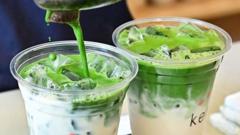The popularity of matcha, the vibrant green powdered tea from Japan, has surged to unprecedented heights, driven primarily by social media influencers and a post-pandemic tourism boom. The hashtag "Matcha Tok" has garnered tens of millions of views, fuelling the demand for matcha-infused products worldwide, from Starbucks lattes to Krispy Kreme doughnuts.
However, this matcha craze has spiraled into a serious supply challenge. Lauren Purvis, a U.S.-based tea importer, reports that her clients are depleting their monthly stock of matcha within days. Cafes now frequently request daily shipments of matcha, desperately trying to keep up with overwhelming customer demand.
The soaring appetite for matcha coincides with disruptions in supply due to several factors, including extreme weather conditions and import tariffs from the U.S. on Japanese products. Farmers, especially in Kyoto—the region responsible for 25% of Japan's tencha (the base for matcha)—are grappling with poor harvests attributed to record-breaking heat. Furthermore, Japan's aging farmer population presents challenges, as fewer younger individuals are entering the industry.
Shops in Kyoto are quickly running out of stock, prompting retailers to impose purchase limits. One such store, Camellia Tea Ceremony, restricts sales to one tin of matcha per customer due to increasing tourist numbers. Similarly, Rie Takeda from Chazen tea ceremony chain highlights the delays in matcha orders, with prices across her outlets rising by approximately 30% this year due to shortages.
Despite the turmoil, the growing interest in matcha production is evident: the Japanese agricultural ministry reported a tripling of matcha production between 2010 and 2023, and a 25% rise in green tea exports last year. Yet, advocates in the matcha community are urging responsible consumption. They emphasize the importance of savoring high-grade matcha in its pure form instead of using it as an ingredient in recipes, which diminishes its unique flavors.
The Global Japanese Tea Association recommends opting for lower-grade matcha, which is more plentiful and suitable for cooking, to ensure the culture behind this prestigious beverage is respected. As the U.S. government imposes a 15% import tax as part of a new trade deal, matcha distributors brace for further price hikes.
While the current demand seems overwhelming, some in the industry, like Masahiro Nagata of Matcha Tokyo, foresee a moderation of the boom within the next few years, suggesting that inflated prices for lower-quality matcha may eventually correct themselves.
As enthusiasts navigate the delicate balance between appreciation and consumption, the future of matcha remains both promising and precarious.





















